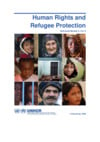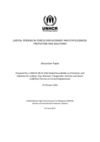UN High Commissioner for Refugees António Guterres: Remarks at the European Parliament, Brussels 28 April 2010 - Informal transcript of remarks
It is a pleasure to be here today. I know how committed the European Parliament is to ensuring that asylum is provided to people in need of international protection.
When we look at the world today, we see that the number of refugees and other forcibly displaced persons has remained relatively stable in recent years. There are about 16 million refugees (including the Palestinian refugees under the mandate of our sister agency UNRWA) and around 27 million persons displaced within their own countries by conflict and persecution. The number of asylum applicants in Europe remained stable overall in 2009 when compared with 2008, though with significant variations in individual countries.
This stability - or stagnation - in numbers shows the resilience of conflicts - for instance in Afghanistan and the Democratic Republic of Congo, the resurgence of conflicts (such as in Southern Sudan), and the difficulty in finding solutions. Last year saw the number of refugees who were able to return voluntarily to their home countries decline by 50% when compared with 2008.1
On the other hand we have worked to increase resettlement and have seen very positive developments with regard to local integration - for instance in Tanzania, where 160,000 long-staying Burundian refugees have recently received Tanzanian citizenship.
When I speak about the resilience and resurgence of conflicts, I am particularly concerned about two clusters of situations.
On the one hand there is an arc of crises which encompasses two-thirds of the world's refugees. It stretches from South Asia through Yemen and the Middle East to the Horn of Africa and on to Sudan and Chad. These crises are interconnected, with links to global security, and are key for the relations between the Islamic world and the West. We need to invest in seeking solutions to these crises.
The other cluster of conflicts is in Central Africa and the Great Lakes region. Here, we see local or regional crises with dramatic humanitarian consequences. However, these crises are not linked to global security concerns. Perhaps as a result, they tend to be forgotten by the wider world - the situation in the Central African Republic is one example.
In this context, asylum in Europe takes on a particular importance. The world looks at Europe to set an example. The development of a Common European Asylum System is a goal UNHCR shares with the European Union. However, currently, we still see very different systems in operation from one EU country to another.
In the context of a single space of free movement, where internal borders have essentially disappeared, such different approaches are problematic. They mean that protection is not assured for people who need it, and they promote secondary movements within Europe.
We are appreciative of the efforts to create a truly common system and we are hopeful about the prospects of such a system coming into being. We see the European Commission's proposed new 'asylum package' consisting of amendments to the first phase asylum instruments as a step in the right direction. We are thus concerned about the resistance these proposals are encountering.
Access to territory is key to accessing protection. States have the right - indeed, the obligation - to manage their borders in a responsible way and to define their migration policies. But in so doing, states must provide protection according to international law. In other words, they must manage their borders in a protection-sensitive way. If they fail to do this, smugglers and traffickers will increasingly take the upper hand, as their networks become the only way to enter. Trafficking in human beings is heinous. States' lack of capacity to crack down on it is rightly a preoccupation. At the same time, we need to be equally preoccupied with protecting the victims of trafficking.
We also need to respond better to the growing problem of anti-foreigner sentiment and xenophobic acts.
With respect to UNHCR, we have been trying to do more and to do better. The European Commission and the EU Member States provide around 40 percent of our support each year. The Commission last year was our second largest donor. We want this money to go to refugees and displaced people, not to bureaucracy.
Since 2006, we have increased our activities by 50% - from $1.1 billion to $1.8 billion, with approximately the same number staff worldwide and 300 fewer at headquarters in Geneva. This represents a very significant gain in productivity. We have reduced Headquarters' staff and costs. We want to continue in this way and to invest in the enhancement of our protection and emergency response capacities, in the response to persons in mixed flows and meeting the needs of refugees and internally displaced people living outside of camps. Protection of internally displaced people is a key issue for us. Refugees have international law and UNHCR to protect them. Internally displaced people remain under the authority of their own governments.
What does the future hold? I see three challenges.
First, the shrinking of humanitarian space. With growing insecurity, it is getting harder and harder to deliver protection and assistance in the field. We had three staff killed in three separate incidents in Pakistan in one six month period last year. In some countries, government actions are limiting humanitarian access. It is increasingly difficult to distinguish between military and humanitarian action in some areas of operation. Roles are confused. For example, MONUC, the UN peacekeeeping force in the Democratic Republic of Congo, is sent to keep peace where no peace exists and becomes embroiled in the conflict. I see the human rights agenda losing ground to national sovereignty.
Second, there is difficulty in bridging the gap between emergency relief and development, making it harder to find sustainable solutions for refugees and displaced people. This is in part due to the way the international community acts and in part to governance problems in the countries concerned.
Third, there are new trends in forced displacement which are challenging for us all. The 1951 Convention responded to displacement due to persecution and war. Today, there are many other drivers of displacement: population growth, urbanization, climate change, food insecurity, scarcity of water, energy demand. The world is getting smaller and for the first time in human history we are at the limits of what the physical environment can bear. These several trends are reinforcing and exacerbating each other, accelerating instability and displacement.
While we have no plans to amend the 1951 Convention, we do need to discuss how we deal with the human rights impacts of these new forms of forced displacement. I hope that the 60th anniversary of the 1951 Convention next year will enable us to be the catalyst of such a debate.
Ladies and gentlemen, thank you very much.
1/ The total number of refugees voluntarily repatriating in 2009 was a little over 250,000.
Your search for « persecution » matched 4722 results. Only the first 1,000 results are displayed. Displaying page 25 of 112 pages.
-

Self-Study Module 1: An Introduction to International Protection: Protecting Persons of Concern to UNHCR
1 Aug 2005 ... ... of their birth in search of safety from persecution, political violence and/or armed conflict. ... The growing phenomenon of refugees fleeing persecution who move alongside fellow nationals who have ...... -

Self-Study Module 5, Vol. II: Human Rights and Refugee Protection
15 Dec 2006 ... ... THE RIGHT TO SEEK AND ENJOY ASYLUM FROM PERSECUTION......1. The Right to Seek and Enjoy Asylum from Persecution ......... -
Lecture by Mrs. Sadako Ogata, United Nations High Commissioner for Refugees, at the University of Chicago Law School Public Service Law Week, Chicago, 25 October 1993
25 Oct 1993 ... humanitarianism helped thousands of its Jewish population to escape persecution and find sanctuary. ... cleansing" has become the new euphemism for persecution, forcing over 4 million people to flee their ...... -

National Activity Plan 2005: United Kingdom
20 Jun 2005 ... 20-26 June, Refugee Week: Focusing on persecution as a root cause of refugee movements. For further ... Free entrance. 13-24 June, Minority Persecution, Harmony House: Three parallel exhibitions on women, ...... -

Refugee Protection and Mixed-Migration: The 10-Point Plan in Action: Chapter 3 Protection-sensitive entry systems. Annex 16 - United States Commission on International Religious Freedom (USCIRF): Report on Asylum-seekers in Expedited Removal, February 2005
1 Jun 2009 ... obligation – and founding tradition – of offering refuge to those suffering persecution. ... strengthen the security of America’s borders, without closing them to those fleeing persecution. ...... -

Refugee Protection and Mixed-Migration: The 10-Point Plan in Action: Chapter 3 Protection-sensitive entry systems. Reference 12 - Refugee Council UK, "Remote Controls: How UK border controls are endangering the lives of refugees", December 2008
1 Jun 2009 ... ... be moving across those borders because they need to escape from persecution and human rights abuses. ... in refugees being unable to escape their countries of origin or being sent back to persecution. ...... -

2021 Global Roundtable LGBTIQ+ Persons in Forced Displacement and Statelessness: Protection and Solutions - Discussion Paper
19 Aug 2021 ... ... with less legal certainty. 1 2. Severe persecution and discrimination from both State and ... for lesbian and bisexual women to flee persecution in their country of origin, to access asylum ...... -

UNHCR Global Trends 2013
20 Jun 2014 ... An estimated 10.7 million individuals were newly displaced due to conflict or persecution in 2013. ... since 1994. During 2013, conflict and persecution forced an average of 32,200 individuals per ...... Attachments: 2013 Global Trends Annex Tables (.zip) -

UNHCR Protection Training Manual for European Border and Entry Officials - 2. The Legal Framework. Annex 10 - Quakification Directive
2011 ... and ensuring that nobody is sent back to persecution. (3) The Geneva Convention and Protocol ... persecu- tion, including the reasons for persecution. (19) Protection can be provided not only by ......
